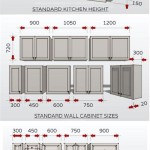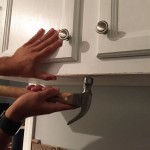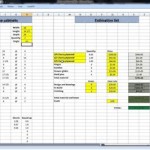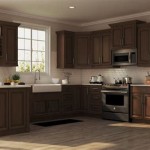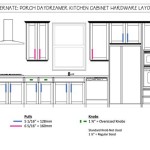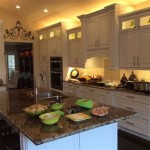Upper Kitchen Cabinet Pulling Away From Wall: Causes, Diagnosis, and Repair
The phenomenon of upper kitchen cabinets pulling away from the wall is a common and concerning issue for homeowners. This separation can progressively worsen, leading to structural instability, potential damage to the cabinets and surrounding areas, and even posing a safety hazard. Addressing this problem promptly and effectively is crucial to prevent further deterioration and ensure the longevity of the kitchen cabinetry.
Several factors contribute to upper kitchen cabinets detaching from the wall. These factors can range from improper installation to excessive weight loading and environmental conditions. Understanding these causes is the first step toward diagnosing the problem and implementing an appropriate solution. Furthermore, a thorough inspection is necessary to assess the extent of the separation and identify any underlying issues, such as wall damage or structural deficiencies.
Proper repair techniques are essential to restore the structural integrity of the cabinets and prevent recurrence of the problem. Depending on the severity of the separation and the underlying causes, various repair methods may be employed. These methods may include reinforcing the existing mounting hardware, adding additional support, or addressing any damage to the wall itself. A well-executed repair will not only secure the cabinets but also ensure their stability and safety for years to come.
Identifying the Root Causes
Numerous factors contribute to the separation of upper kitchen cabinets from the wall. Understanding these causes is essential for selecting the appropriate repair strategy. One of the most common culprits is inadequate installation. If the cabinets were not properly secured to the wall studs during the initial installation, they may gradually pull away over time under the weight of their contents. This is particularly true if the cabinets are heavily loaded with dishes, cookware, or other items.
The type of wall construction also plays a significant role. Drywall alone is generally not strong enough to support the weight of upper kitchen cabinets. Cabinets should be anchored to wall studs, which provide a solid and reliable mounting surface. If the cabinets are only attached to drywall, the drywall anchors may fail over time, causing the cabinets to sag and eventually pull away from the wall. The quality and type of fasteners used during installation are also crucial. Inferior screws or improperly sized fasteners may not provide sufficient holding power, leading to eventual failure.
Furthermore, water damage can significantly compromise the structural integrity of the wall and the cabinets themselves. Leaks from plumbing fixtures, such as sinks or dishwashers, can seep into the wall cavity and weaken the wood framing and drywall. This moisture can also cause the wood in the cabinets to rot, further reducing their ability to support weight. Evidence of water damage, such as discoloration, staining, or mold growth, should be thoroughly investigated and addressed before attempting to repair the cabinet separation.
Another contributing factor is overloading the cabinets with excessive weight. Exceeding the weight capacity of the cabinets can place undue stress on the mounting hardware and the wall itself. This is especially problematic for cabinets containing heavy items such as canned goods, appliances, or stacks of dishes. Distributing the weight evenly throughout the cabinets and avoiding overloading them can help prevent separation from the wall.
Finally, structural issues within the wall itself can contribute to cabinet separation. If the wall studs are damaged, rotted, or improperly spaced, they may not provide adequate support for the cabinets. This can be particularly problematic in older homes where the wall framing may have deteriorated over time. In such cases, it may be necessary to repair or reinforce the wall framing before reattaching the cabinets.
Diagnosing the Extent of the Problem
A thorough inspection is essential to accurately assess the extent of the cabinet separation and identify any underlying damage. The first step is to visually examine the cabinets and the surrounding wall for any signs of separation, sagging, or misalignment. Pay close attention to the gaps between the cabinets and the wall, as well as any cracks or damage to the drywall. Use a level to check if the cabinets are plumb and level. If the cabinets are significantly out of alignment, it indicates a more severe problem that requires immediate attention.
Next, inspect the mounting hardware and the wall studs. Check the screws or bolts that secure the cabinets to the wall for signs of loosening, corrosion, or damage. Use a stud finder to locate the wall studs and verify that the cabinets are properly anchored to them. If the cabinets are only attached to drywall, it indicates a significant installation flaw that needs to be corrected. The stud finder should also be used to assess for inconsistencies in the spacing suggesting possible structural modifications to the wall that could affect support.
Carefully examine the wall behind the cabinets for any signs of water damage. Look for discoloration, staining, mold growth, or other evidence of moisture penetration. If water damage is present, trace the source of the leak and repair it before proceeding with any cabinet repairs. Ignoring the water damage will only lead to further deterioration and potentially compromise the structural integrity of the wall and the cabinets.
Assess the condition of the cabinets themselves. Check for cracks, warping, or rot in the wood. Pay close attention to the areas around the mounting hardware, as these are the most vulnerable to damage. If the cabinets are severely damaged, it may be necessary to replace them entirely.
Consider the age of the cabinets and the overall condition of the kitchen. Older cabinets may be more prone to separation due to wear and tear, while a poorly maintained kitchen may indicate underlying problems that contribute to the issue. A comprehensive assessment of the entire kitchen environment can provide valuable insights into the causes of the cabinet separation.
Implementing Effective Repair Strategies
The appropriate repair strategy will depend on the severity of the cabinet separation and the underlying causes. For minor separations, simply tightening the existing mounting hardware may be sufficient. Use a screwdriver or wrench to tighten any loose screws or bolts that secure the cabinets to the wall. Be careful not to overtighten the fasteners, as this could strip the threads or damage the surrounding wood.
If the existing screws are stripped or damaged, replace them with new ones that are slightly longer and thicker. This will provide a more secure connection between the cabinets and the wall studs. Consider using lag screws or toggle bolts for added strength, especially if the cabinets are heavily loaded. These fasteners are designed to provide a stronger grip in drywall and can significantly improve the stability of the cabinets.
For more severe separations, it may be necessary to add additional support to the cabinets. One option is to install a ledger board along the wall behind the cabinets. The ledger board is a piece of wood that is securely attached to the wall studs and provides a solid base for the cabinets to rest on. This can help distribute the weight of the cabinets more evenly and prevent them from pulling away from the wall. Make sure the ledger board is properly sized and securely fastened to the wall studs.
Another option is to install additional cabinet mounting brackets or straps. These brackets or straps can be attached to the wall studs and the cabinets to provide extra support. This is particularly useful for cabinets that are heavily loaded or that are prone to separation. Choose brackets or straps that are made of durable materials and are designed to withstand the weight of the cabinets.
If the wall studs are damaged or rotted, they will need to be repaired or replaced. This is a more complex repair that may require the assistance of a professional contractor. Repairing or replacing the wall studs will provide a solid and reliable mounting surface for the cabinets and prevent further separation. It is essential to address any structural deficiencies in the wall before reattaching the cabinets.
In cases of significant water damage, it is crucial to address the source of the leak and repair any damaged drywall or framing. Remove any mold or mildew and allow the area to dry completely before proceeding with any cabinet repairs. Replacing the damaged drywall and framing will ensure a solid and stable base for the cabinets and prevent future problems.
Finally, consider the overall design and layout of the kitchen. If the cabinets are poorly designed or if the layout is not conducive to proper weight distribution, it may be necessary to make modifications to the kitchen design. This could involve adding additional storage space, redistributing the weight of the items in the cabinets, or even replacing the cabinets with a more suitable option.

Cabinets Pulling Away From Wall

Cabinet Bowing Out At Top On One End Hometalk

Cabinets Pulling Away From Wall Doityourself Com Community Forums

How To Take Down Kitchen Cabinets Rehang One Young House Love

Cabinets Pulling Away From Wall Doityourself Com Community Forums

How To Remove Kitchen Cabinets Budget Dumpster

How To Repair A Kitchen Cabinet That Is Pushing Out On The Side Hometalk

How To Remove Kitchen Cabinets A Diy Guide Dumpsters Com
Kitchen Cabinet Above Sink Pulling Away From Wall Forest River Forums

How To Remove Kitchen Cabinets Budget Dumpster
Related Posts

